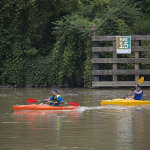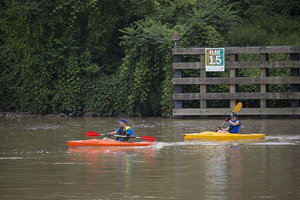CLEVELAND—Tim Gottshall paused in mid-paddle, his kayak drifting for a moment on the Cuyahoga River, to consider the question: Is the water safe?
“Well,” he replied, “I’m not drinking it.” But splashing a bit as he paddled: no problem.
Nearby on Wendy Park, where the river meets Lake Erie, Jermaine Eggleton was pulling catfish and bass out of the Cuyahoga. A jet-skier offshore tumbled in the water, laughing. And Tom Rousher and Paul Grande, almost finished a 20-mile Sunday bike ride, said they would have no problem eating fish from the river, “though no more than two a week,” allowed Mr. Rousher.
The mere fact that there are fish, fishermen, bikers, and boaters in and about the Cuyahoga River is a dramatic example of progress, one that Wayne Bratton welcomes with a mix of emotions as he watches the river’s busy scene from his boat.
Captain Bratton is a self-described “river rat,” hobbled by his fifth hip replacement but still plying the Cuyahoga River and Lake Erie. Now in his 80s, he takes groups of kids with disabilities, scuba divers, police honorees, wedding parties – “anyone, anytime, for anything that’s legal, or reasonably close” – aboard his 65-foot cruiser, Holiday. In his career on the water starting as a seaman, he rose to captain huge container ships, moved ashore to manage a shipping fleet, and invested in an oil tanker company.
He sailed on – and profited from – the fouled arteries of grimy, belching, industrial Cleveland. And it was one of those key waterways, the Cuyahoga River, that caught fire nearly five decades ago, making Cleveland and its river the poster-child of the fledgling environmental movement.
The fire June 22, 1969, started from a splash of molten metal from a steel plant conveyor onto oil-soaked debris in the river below. It was doused quickly – before photographers arrived – and was of little concern in Cleveland. “It was just another day on the water” on a river that – like many of the nation’s industrial rivers – had caught fire repeatedly before, Mr. Bratton recalls. But then Time magazine picked it up, with a slightly misleading “file photo” of a dramatic blaze at the same spot 17 years earlier.
The river was profiled as something that “oozes rather than flows,” was biologically dead, a place that locals joked would dissolve you before you drowned.
That was fair, Bratton concedes. “Seriously, it bubbled like a cauldron from all the chemicals. And it had a unique odor. If you were off watch and woke up below decks, you knew you were in Cleveland from the smell.”
The Time story came just as youthful outrage over the Vietnam War was spilling into the environment, and the public was waking up to the realization that it should be incredulous that rivers could catch fire. Carl Stokes, the country’s first African-American elected mayor, went before Congress to demand help. His brother, Rep. Louis Stokes, helped get passage of the National Environmental Policy Act and the Clean Air Act in 1970, the Clean Water Act in 1972, and the formation of the Environmental Protection Agency in 1970 – all pillars of the ambitious scrubbing of polluted America that followed.
Bratton applauds the cleanup. Gradually, the tanneries and paint manufacturers and steel plants that lined the last six miles of the Cuyahoga River leading to Lake Erie stopped seeing the waterway “as this lovely sewer where we can just throw everything in the river,” Bratton says.
But he has caveats. Bratton notes them carefully like the business and law student he eventually became. He says industry had started reforming itself before the fire.
“We knew we had a problem. We knew it needed to be addressed,” he says. Some of the cleanup techniques that eventually scraped the chemicals from the surface of the river and dragged garbage out of it were being developed by industry before the 1969 fire, he says.
In fact, Bratton notes, industry has long-ago cleaned up its act, while local and regional agencies still have not fully stopped raw sewage flowing into the river after fierce rainstorms, a chief contaminant. And they have done little to address the more general toxic runoff from roads and parking lots and agricultural fields.
Jane Goodman agrees. A former radio producer inspired by the 1990 Earth Day and now head of the Cuyahoga River Restoration, she says the cleanup of the river is not finished. But the fire helped hold a mirror to the city.
“You can’t change your brand unless you change the underlying image,” Ms. Goodman says. “In our case, the burning river moniker, the fires, the Rust Belt, the dying-city image is something we still have to rise from. But the generations now understand that being able to say we did this is almost as important as having done it.”
With winking irony, the city even sports a Burning River Beer.
Forty miles upriver, at the town of Cuyahoga Falls, Elaine Marsh is a watershed specialist for Summit Metro Parks, a regional agency that is slowly accumulating preserved land on the swift whitewater of the Cuyahoga’s upper 94 miles. She stands above a glistening stretch of racing rapids and fast waterfalls, comparing them with 100-year-old photos of the narrow river hemmed in by a jumble of factories.
“The fire is now part of the myth of the river. And by myth, I mean something that inspires,” she says. “We like to think of the Cuyahoga as a phoenix rising out of the ashes of the fire. Could that have happened without the fire? It’s like asking if slavery would have ended without the Civil War. Probably, but not for a long time.”
Sitting on the bow of the Holiday at dock in Cleveland, Bratton agrees. The signs of the revival pass by the port side of his boat: colorful sculls with rhythmic rowers, kayakers, and pleasure boaters, some of whom hail him by name.
“That’s what tells me the river is back. Nobody would have come down here before.”
But, like the ship captain he is, he frets that the river’s newfound popularity brings new dangers. Mixing a merry recreational scene with the heavy hauling that is still the river’s main chore is dangerous. The day before, the 630-foot Robert S. Pierson squeezed up the mouth of the river to take on a load of salt. It turned the corner to the old river arm with barely a dozen yards to spare on either side, a delicate pirouette that was celebrated by jet skiers and kayakers playing under its bow.
Wash from the side thrusters of the ship could easily capsize those pleasure craft, and a broadside wind could pin the ship against the steel-lined shore, squashing an errant kayaker, Bratton worries.
“They all want to know, ‘How did we clean it up?’ ” Bratton muses. “I tell them we just did. Everybody felt it was a personal responsibility.”

